NDVI stands for "Normalized Difference Vegetation Index". NRG stands for "Near-infrared / Red / Green". NDVI and NRG are both ways to visualize the amounts of infrared and other wavelengths of light reflected from vegetation. Because both these methods compare ratios of blue and red light absorbed versus green and IR light reflected, they can be used to evaluate the health of vegetation. It's a snapshot of how much photosynthesis is happening. This is helpful in assessing vegetative health or stress. (Read more here: https://www.agronomy.org/publications/jeq/articles/36/3/832) ## Do-It-Yourself These techniques for vegetation analysis were developed for satellite imagery, but at Public Lab, we've been working a lot on capturing infrared imagery using our DIY [near-infrared camera](/wiki/near-infrared-camera) setup, and combining it with visible bands to produce NDVI images such as the one above. ## What these images mean What exactly are these images we're trying to make? What do they tell us about vegetation, and why? These diagrams should help to understand what it is we're doing and why these are good ways to analyze plant life. ## The NDVI equation [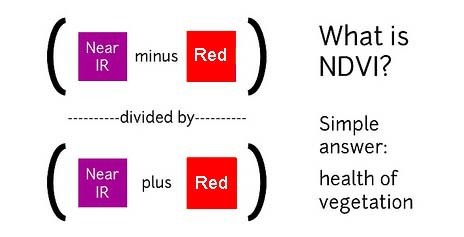](/i/44723) **NDVI = (Near Infrared - Red)/(Near Infrared + Red)** NDVI is a ratio which tries to emphasize photosynthesis while filtering out sun glare. The above equation is run for every pixel, using source data from an infrared photo and a visible light photo, like this pair: [](https://publiclab.org/system/images/photos/000/021/771/original/5390895115_c9d4d38fec_o.jpg) The result can be false-colored to make the high-photosynthesis areas more clear, and used to examine where plants are and how healthy they are. [](https://publiclab.org/system/images/photos/000/021/770/original/PetVISNDVIcomp.png) _Figure above: Normal color photo (right) and normalized difference vegetation index (NDVI) image (left). NDVI image was derived from two color channels in a single photo taken with a camera modified with a special infrared filter. Note that tree trunks, brown grass, and rocks have very low NDVI values because they are not photosynthetic. Healthy plants typically have NDVI values between 0.1 and 0.9. -- @cfastie_ ### Activities Here are a range of activities you can do to produce and interpret your own NDVI imagery, whether downloaded from a satellite imagery provider or [collected yourself using a DIY technique](/wiki/multispectral-imaging) [activities:ndvi] ****   Most DIY converted cameras today (those from Public Lab) use RGN instead of NRG, so the blue channel represents infrared instead of the red channel. That looks like this: [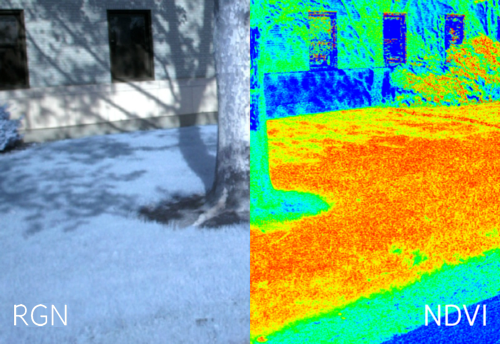](/i/45468?s=o) **** ## NRG imagery Some people are also interested in producing NRG imagery (like the below image), where `Near-Infrared, Red, and Green` are used to compose a picture instead of the usual `Red, Green, and Blue`. [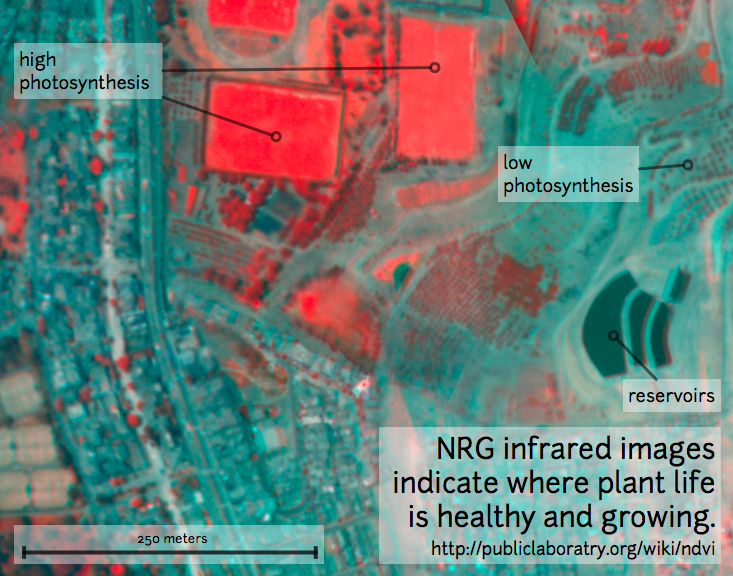](/i/25064) This diagram explains the swapping, which allows us to 'see' infrared as if it were a normal color: [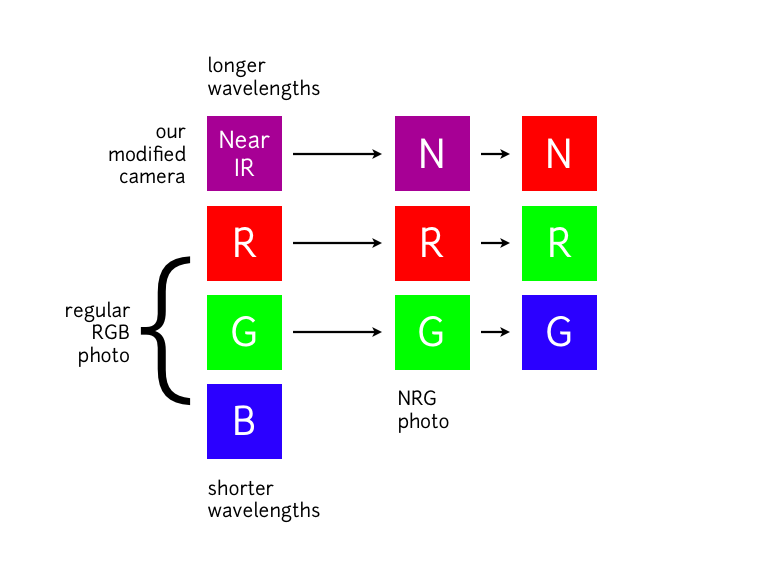](/i/25063) **In NRG images, the deeper and clearer the red color, the denser and healthier the vegetation (more or less).** ### Questions [questions:ndvi] ### Other examples of DIY NDVI imaging From around the internet: Begin watching at 2 minutes to see the resulting imagery: *This topic is part of the [Grassroots Mapping Curriculum](/wiki/mapping-curriculum) series.* **** [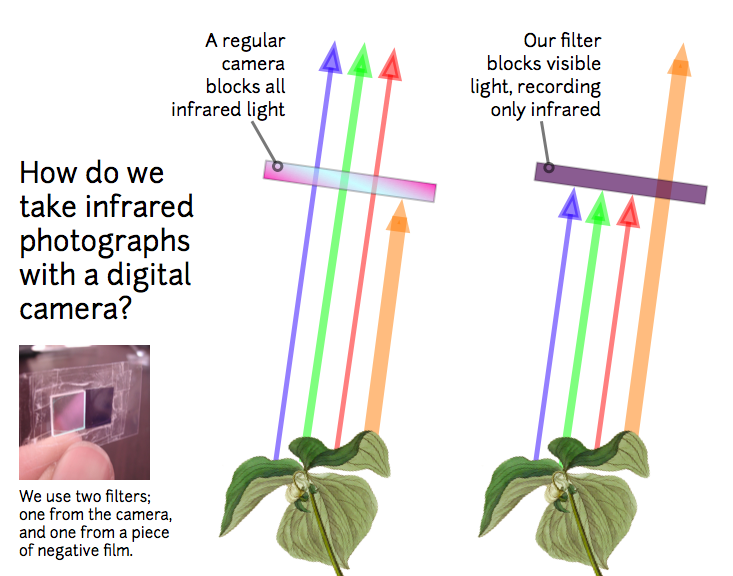](/i/25066) [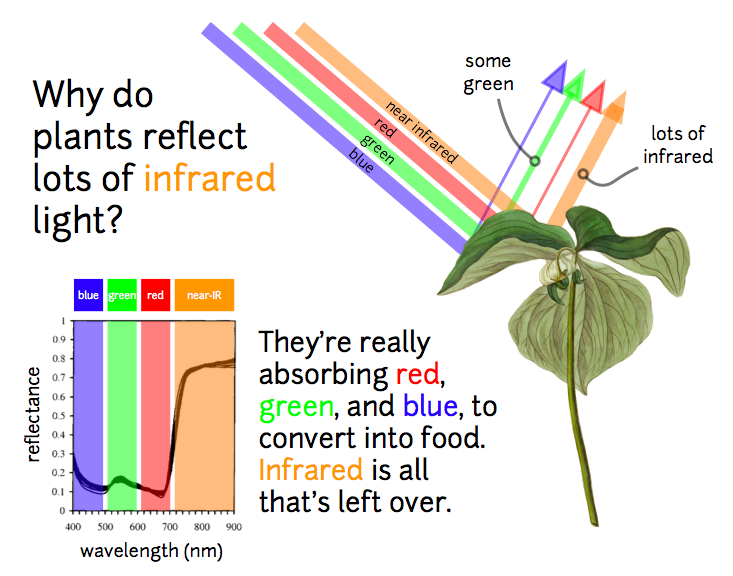](/i/25065) ...
| Author | Comment | Last activity | Moderation | ||
|---|---|---|---|---|---|
| Butterflyhoodie | "Butterfly Hoodie collection is available on Official Butterfly Store. Collect Butterfly Shirts, jeans and Vlone products. Amazing discount. Butter..." | Read more » | almost 2 years ago | |||
| Butterflyhoodie | "Butterfly Hoodie collection is available on Official Butterfly Store. Collect Butterfly Shirts, jeans and Vlone products. Amazing discount. " | Read more » | almost 2 years ago | |||
| rishabh326_info | "An infrared camera (also known as a thermal imager) detects and measures the infrared energy of objects. The camera converts that infrared data int..." | Read more » | almost 2 years ago | |||
| sobhasentosa | "Sobha Sentosa " | Read more » | about 2 years ago | |||
| saberali0721 | "If you're a fan of hunting, the 8Xbet trò chơi săn mồi in Vietnam might be for you. This card game is a modern version of the traditional Vietnames..." | Read more » | about 2 years ago | |||
| animixplayvc | "AnimixPlay is the best free anime streaming website that allows you to stream and download thousands of English subtitles and dubs in Ultra HD qual..." | Read more » | about 2 years ago | |||
| prestigeastonparkflats | " Prestige Aston Park is one of the stylish developments by prestige groups in Bangalore with 1 2 and 3 bhk apartments apartments estates lodges e..." | Read more » | about 2 years ago | |||
| Alia999 | "Here is Link for best answer " | Read more » | about 2 years ago | |||
| 12A | "https://apkashub.net/ " | Read more » | about 2 years ago | |||
| gadgets_africa | "Points that help you with regards to buying the best Smartphones Nairobi There are many users who want to know the basic points that one should ch..." | Read more » | over 2 years ago | |||
| Ag8n | "It looks like a single beam instrument was used for this work. With a double beam instrument, there is no need for phrases like "OD435/OD415". Th..." | Read more » | over 2 years ago | |||
| imvec | " @imvec has marked @xose as a co-author. " | Read more » | over 2 years ago | |||
| warren | "wow the blue color of your image looks quite good. It could be interesting to take a picture of some grass or some vegetation that's more consisten..." | Read more » | over 2 years ago | |||
| xose | "You can use the pi-builder to embed it on a Raspberry pi. The software consists in a camera interface, the image sequencer and the infragram ;D ht..." | Read more » | over 2 years ago | |||
| Ag8n | " Lichen1.docx Hopefully, this will attach. " | Read more » | over 2 years ago | |||
| Ag8n | "In this area, lichens aren't common. Attached is a rough draft using lawn clippings to set up and test using various instruments. Don't know how ..." | Read more » | over 2 years ago | |||
| bhamster | "Hi @jdetka, this question by @patalbright and the comments section might have some tips to try: How to find the sweet spot for manual white balance..." | Read more » | over 2 years ago | |||
| jdetka | "Hello, Did you make any additional progress with this? I'm trying to do the same thing and maybe we can collaborate on a solution. " | Read more » | over 2 years ago | |||
| jdetka | "Is there a way to run the infragram code locally on a PC? I'll be in a region that doesn't have internet but I still want to be able to analyze ima..." | Read more » | over 2 years ago | |||
| scottroger411 | "thanks for sharing this information with me. " | Read more » | over 2 years ago | |||
| Ag8n | "The tungsten lamp remarks only apply to the 660 nm red lines. " | Read more » | over 2 years ago | |||
| Ag8n | "Best bet- use an old fashioned tungsten lamp. Not a LED claiming to be a tungsten lamp. An LED has a narrow bandwidth. An old fashioned tungsten..." | Read more » | over 2 years ago | |||
| Ag8n | "Looking into the 660 nm lines. It's not that LEDs don't exist for 425 nm region. They do. But the ones in the catalogs seemed expensive. Going ..." | Read more » | over 2 years ago | |||
| Ag8n | "There are 3 in 1 flashlights ( blue, white, and red) that would be good for this application- as long as the color was more like purple instead of ..." | Read more » | over 2 years ago |